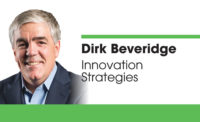If you want to drive innovation within your organization – which I believe is critically necessary throughout the distribution industry – you need to be in the vision business. You need to constantly think, dream and imagine.
Dream of the type of business you want to create, not today but tomorrow. Don’t be afraid to go out to the world, to the industry, to your employees and dream aloud. When you dream aloud, sometimes people are going to say you’re crazy. Don’t let their words stop you. Instead, think about what the musical group U2 says about the future and how our only limits are the limits of our imagination.
The visioning spectrum
I want to share a model with you that will help you bring the concept of “anything is possible with vision” into your organization. I call this “The Visioning Spectrum.”
Good, bad or indifferent, most distributors are managing their businesses for today. They’re at the status quo on one side of the spectrum. Your business is likely among them. You most likely have a good business (and no doubt a profitable one), but you’re managing it for today. On the other side of the spectrum is a disruptive future. By using your vision to look ahead to that future, you’re preparing for it.
As a leader in your organization, you must ensure you aren’t just innovating for today, but are trying to be sustainable, relevant and profitable in the future.
To do that, take stock of your current situation. Your management activities are driving certain levels of performance and that performance is driving results for your current generation of customers and employees. Look around your offices at your employees and also look at your customers. You’re performing to meet their current needs. However, as you move toward that other side of the spectrum, think about how you can innovate not just for your current customers and employees, but for that next generation of customers and employees.
Today, you’re probably driving incremental changes. Most distributors look for a 2% or 3% improvement in their warehouses, through their sales activities and so on to drive incremental growth. If you want to bridge the gap from managing for today to innovating for the future, prioritize how you invest your resources and put into place a process for somehow seeing into the future. Remember, the future is already here, it’s just not evenly distributed.
Have the discipline to continually ask, “Where must we drive this business? How must we innovate?” So much is going on at any one moment: Technology changes, government regulations, generational changes, varying business models, customer demands, and so on and so forth.
Figure out how these changes will impact your customers because innovation is about leading your customers to a better future in which they are willing and capable of rewarding you. Any major, systemic shift that affects your company will likewise impact your customers, so it’s important to have sensors in place to identify and understand the previously mentioned mega trends.
From there, figure out how these trends are going to impact your company (or industry) so you can make judgments and informed decisions.
Once you get past that level, start making informed decisions relative to how these trends are going to impact distribution. Think about it not just from a distribution perspective. Ask yourself, “How is this shift going to change the outcomes our customers will be looking for? How will it change their desired outcomes regarding profitability and productivity? How will the demographic changes affect the availability of labor and our customers’ ability to recruit labor?”
From there, begin looking into the day-to-day needs of your customers. Use this model of peering into the future to begin crafting your vision.









